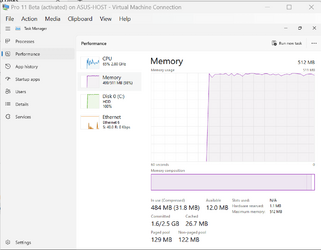- Local time
- 2:30 AM
- Posts
- 7,430
- OS
- Windows 11 Pro + Win11 Canary VM.
Pretty sure same is true but we have yet to have a build upgrade. Could try with a repair upgrade or manual upgrade from W10 to W11 I suppose.I've tried to follow this thread. I've only been involved in a couple of these low grade machines. In Windows 10, when an upgrade came down the pike and a machine did not have enough storage, the process would tell me. I could insert a usb drive, point to it and the upgrade would use it to create the windows.old folder. Then the machine would upgrade. Is that no longer possible in WIndows 11 without jumping through all these hoops? Just askin'.
Anyway, you can always use my clone to hyper-v vhdx upgrade method and reclone back to device method - done it many times.
My Computer
System One
-
- OS
- Windows 11 Pro + Win11 Canary VM.
- Computer type
- Laptop
- Manufacturer/Model
- ASUS Zenbook 14
- CPU
- I9 13th gen i9-13900H 2.60 GHZ
- Motherboard
- Yep, Laptop has one.
- Memory
- 16 GB soldered
- Graphics Card(s)
- Integrated Intel Iris XE
- Sound Card
- Realtek built in
- Monitor(s) Displays
- laptop OLED screen
- Screen Resolution
- 2880x1800 touchscreen
- Hard Drives
- 1 TB NVME SSD (only weakness is only one slot)
- PSU
- Internal + 65W thunderbolt USB4 charger
- Case
- Yep, got one
- Cooling
- Stella Artois (UK pint cans - 568 ml) - extra cost.
- Keyboard
- Built in UK keybd
- Mouse
- Bluetooth , wireless dongled, wired
- Internet Speed
- 900 mbs (ethernet), wifi 6 typical 350-450 mb/s both up and down
- Browser
- Edge
- Antivirus
- Defender
- Other Info
- TPM 2.0, 2xUSB4 thunderbolt, 1xUsb3 (usb a), 1xUsb-c, hdmi out, 3.5 mm audio out/in combo, ASUS backlit trackpad (inc. switchable number pad)
Macrium Reflect Home V8
Office 365 Family (6 users each 1TB onedrive space)
Hyper-V (a vm runs almost as fast as my older laptop)









